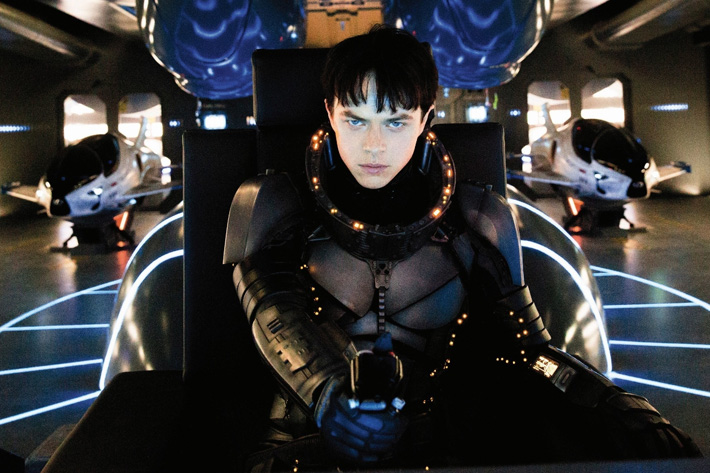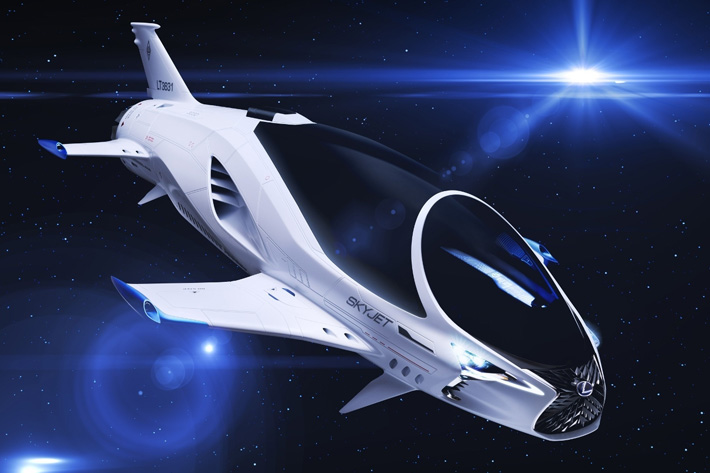
Valerian, the film, picks the comic series from 1967 and mixes it with a promise of the future: the Skyjet vehicle designed by Lexus for a world set 700 years in the future. Time to look at Luc Besson’s love and a dream which started half a century ago.
The first trailer from Valerian and the City of a Thousand Planets, revealed last November, gave viewers a glimpse of the Skyjet, a single-seat pursuit craft featured in the film. The vehicle is the result of a cooperative work between the team behind Valerian and Lexus, challenged to create a vehicle grounded on reality but existing in the future universe of Valerian.
The creative team met with Lexus’ Chief Engineer, Takeaki Kato and the Lexus design team, to discuss incorporating believable, imaginative technologies and contemporary design cues into the final iteration of the Skyjet. The result is a craft the being futuristic includes an adapted interpretation of Lexus’ signature “spindle” grille, and a similar headlight design to that of the anticipated 2018 Lexus LC coupe, defined by an athletic and aerodynamic shape.

The Skyjet vehicle and the technology that makes the film possible, are the only modern elements of Valerian, because the story is old, a sci-fi saga that started back in 1967, when the first adventure of Valerian and Laureline (yes, because there is a heroine in the series) was published in Europe, in the French magazine Pilote. The comic book series, created by writer Pierre Christin and artist Jean-Claude Mézières, was published until 2010, a total of 21 volumes plus a short story collection and an encyclopedia. The books are being reissued now, in special editions that hope to explore the public’s interest in the film.
https://youtu.be/g3jvPnIAmFE
In 2012 Luc Besson announced that he wanted to make a film based on a comic book from his youth. The idea of adapting the adventures of Valerian and Laureline to the cinema was not new, though. Since Besson made The Fifth Element (1997), also based on a French comic series, that he wanted to do it, but the director felt the technology available would not allow to reproduce the unique universe of the spatio-temporal agents. It was only after Avatar, from James Cameron, that Luc Besson believed the conditions were met, and started to think of Valerian as a film. Or more, as the director suggested in a recent interview: “I will be the happiest guy in the world if the film works and I can do a second one and a third one.”
Are we about to see another saga like Star Wars?
https://youtu.be/dK8B10_oY5g
Valerian, as multiple articles on the Internet have enumerated over and over, is one of the sources for Star Wars. The comparison reveals so many “coincidences” that it is hard to believe it’s just a coincidence. From Princess Leia’s costume worn in Return of the Jedi, very similar to the slave-girl outfit that Laureline wears in The Land Without Stars (1972), to the figure with a burned face present in Empire of a Thousand Planets, from 1971, which is similar to Darth Vader (Anakin Skywalker), going through the Millenium Falcon and Valerian’s spaceship or the way Valerian is frozen in liquid plastic, in the same comic book, and Han Solo is imprisoned in carbonite in The Empire Strikes Back of 1980, nine years later, there are too many coincidences.
https://youtu.be/KcQSPrNu-Sw
An interview with Pierre Christin, by Martin Scholz of the German newspaper Die Welt, (available in English at Europe Comics, under the title Valerian: A Model for Star Wars), touches the subject. The journalist asks if the authors were surprised when they saw, ten years after their first comic book came out, the first episode of Star Wars borrowing heavily from their characters, creatures and design of spaceships and Pierre Christin replies that “Yes, that’s exactly what my colleague Jean-Claude Mézières and I told ourselves when we walked out of the cinema after watching Star Wars for the first time. But my first reaction was not anger.”
In the same interview Pierre Christin comments that “In the ’80s, particularly in France, people were convinced that George Lucas had stolen from Valerian” and adds that “in general, all you hear from the US in reply to such allegations is that French comics are barely known and not successful at all on that side of the Atlantic – which, on the whole, is true. Nevertheless, the few people in the US who do know French comics fairly well are Hollywood’s art directors and storyboard artists. They might not be able to read the magazines, but they still flick through them now and then in search of ideas. That’s what French film-makers who’ve been to Hollywood have told me: They happened to have seen piles of French comics in the creative departments of various film studios.”
One important element that many seem to forget is the influence that, without any doubt, one French magazine had in Hollywood. Metal Hurlant, a comics magazine launched in France in 1975 was renamed and launched in the United States in April 1977 as a monthly magazine, Heavy Metal. The artists published in the magazine included names as Jean Giraud (a.k.a. Moebius), Philippe Druillet or Enki Bilal. Although the first Valerian and Laureline album translated to English was Ambassador of Shadows, published in Heavy Metal in 1981, it’s only natural that Heavy Metal, which is still published today in the United States, attracted the attention of a whole generation of artists when it was launched, and made French and Belgian comics and European comics in general even more popular with a generation after new visions.
The cross-influence from comics to cinema should not come as a surprise and Star Wars is not the only case. In fact, Luc Besson’s film The Fifth Element is said to have “borrowed” the idea from the comic series The Incal, created in 1980 by comics writer Alejandro Jodorowsky and artist Moebius (Jean Henri Gaston Giraud). Moebius did contribute storyboards and concept designs to the movie, but some suggest that Besson used more than just the storyboards. In a 2002 interview published by Danish comic book magazine Strip, Jodorowsky said it was an honour to have his ideas stolen.
https://youtu.be/jg4OCeSTL08
Moebius and Jodorowsky are also associated with another project that never saw the light of day, at least as Jodorowsky meant it, but which, apparently, was used in Hollywood as “guide-book” for science-fiction films: Dune. A documentary from 2013, Jodorowsky’s Dune, reveals that the “film notes, Jodorowsky’s script, extensive storyboards and concept art were sent to all major film studios”, and argues that these inspired later film productions, including the Alien, Star Wars and Terminator series.
Still looking at Star Wars and Valerian, it is also interesting to see that Valerian and Han Solo seem to have similar traits, while Laureline is basically Princess Leia. One other element usually not mentioned, but that fascinates me, is that Luke Skywalker lives as a farmer with his adopted family until he starts training to be a Jedi, while Laureline is a 11th century French peasant brought from the past by Valerian and trained to become a space-agent. Both heroes are farmers, both are taken from their element to receive training…
Valerian and the City of a Thousand Planets launches in cinemas around the world starting next week. In the United States it will be available in 2D and 3D beginning 21 July 2017, and it will be interesting to see how the public receives Luc Besson’s adaptation. Featuring an all-star cast including Clive Owen, Ethan Hawke, Rihanna, and Kris W, the project marks Luc Besson’s most ambitious film to date and the largest-budget European motion picture ever produced. The film is produced by Virginie Besson-Silla.
Having collected Valerian and Laureline stories throughout the years, since they first appeared, I must admit I am very curious to see the film, because, as Luc Besson, I always thought the comic deserved to be translated to the cinema. Knowing the series, I also hope this Valerian and Laureline film opens the door for more films, because it would be fantastic to see the evolution of the saga beyond the first books. In fact, while Star Wars became a sterile universe after the first three films, in my opinion, the stories created by Pierre Christin and Jean-Claude Mézières have evolved, from the exciting sci-fi adventure from the initial books to stories touching multiple political and social topics that could just be the base for sequels to the saga.
The film gives us an image of Laureline that corresponds to the image the comic series build of her throughout the different albums. As Gabrielle Bellot wrote recently in The Atlantic, Laureline was, “from the start, a radically impressive figure who set the bar high for women in science fiction. No mere beautiful figure, Laureline has a piercing intellect, a near-indomitable pride in herself, an endearing but acid wit, and formidable fighting skills. And yet she resists being an archetype of female perfection.”
It’s easy to understand why Luc Besson says that he fell in love with Laureline when he first read the comics. It’s a love and adventure that started 50 years ago.

